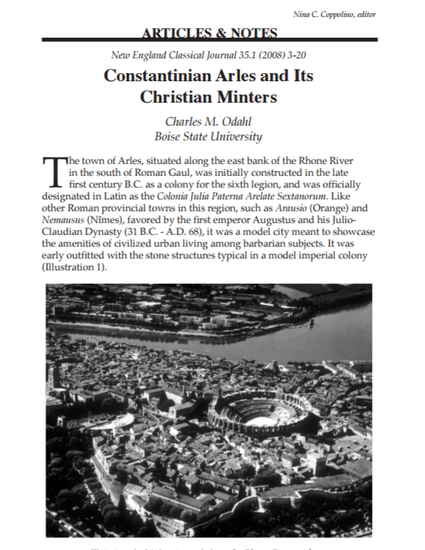
Article
Constantinian Arles and Its Christian Minters
New England Classical Journal
(2008)
Abstract
The town of Arles, situated along the east bank of the Rhone River in the south of Roman Gaul, was initially constructed in the late first century B.C. as a colony for the sixth legion, and was officially designated in Latin as the Colonia Julia Paterna Arelate Sextanorum. Like other Roman provincial towns in this region, such as Arausio (Orange) and Nemausus (Nîmes), favored by the first emperor Augustus and his Julio-Claudian Dynasty (31 B.C. - A.D. 68), it was a model city meant to showcase the amenities of civilized urban living among barbarian subjects. It was early outfitted with the stone structures typical in a model imperial colony. It was surrounded by a circuit wall which enclosed a checkerboard grid street plan based upon a north-south cardo avenue and an east-west decumanus avenue. At one end of the town, it had a large two story 446’ by 351’ amphitheater which could hold over 21,000 spectators for gladiatorial combats and beast fights, and a 335’ diameter theater which could seat 7,000 people for dramatic presentations and literary readings. In the center of the town where the major avenues intersected, there was a market place for shopping activities and a forum for public business; the Museum of Pagan Art displaying a statue of Augustus and a provincial copy of his Shield of Virtues now resides at the former site, and a remnant of a Temple of Roma and Augustus is embedded in a hotel wall occupying the latter site. The homes, shops, and bathhouses which graced the ancient town of Arelate are now largely replaced by the structures of the modern city of Arles. Although it was not a provincial capital, such as Narbo or Lugdunum, the wealth of its Roman remains still in situ and in museums reveals that it was a prosperous provincial town which benefited from its Augustan foundation and its strategic location on key land and sea trade routes during the pax Romana of the early empire.
Disciplines
Publication Date
2008
Citation Information
Charles Odahl. "Constantinian Arles and Its Christian Minters" New England Classical Journal Vol. 35 Iss. 1 (2008) p. 3 - 20 Available at: http://works.bepress.com/charles_odahl/12/
